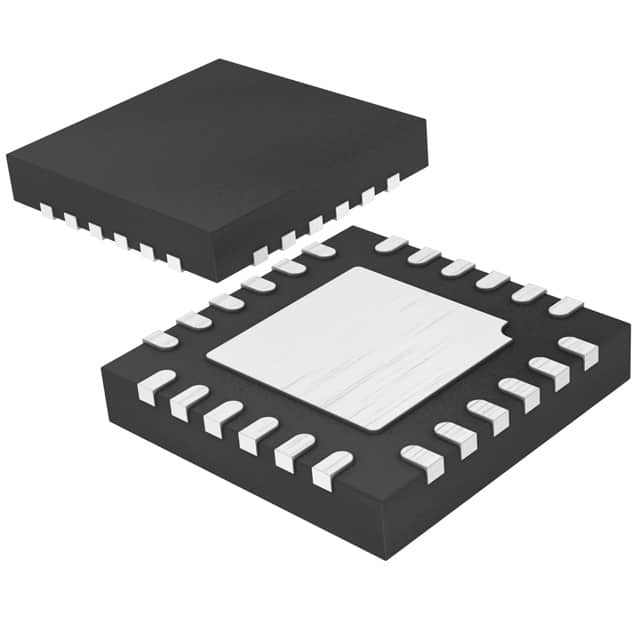Xem thông số kỹ thuật để biết chi tiết sản phẩm.

LTC3737EUF#PBF
Product Overview
Category: Integrated Circuit (IC)
Use: Power Management
Characteristics: - High Efficiency - Wide Input Voltage Range - Adjustable Output Voltage - Synchronous Buck-Boost Topology
Package: 4x5mm QFN-24
Essence: The LTC3737EUF#PBF is a high-performance integrated circuit designed for power management applications. It offers a wide input voltage range and adjustable output voltage, making it suitable for various power supply designs.
Packaging/Quantity: The LTC3737EUF#PBF is available in a 4x5mm QFN-24 package. It is typically sold in reels of 2500 units.
Specifications
- Input Voltage Range: 2.25V to 20V
- Output Voltage Range: 0.8V to VIN
- Maximum Output Current: 10A
- Switching Frequency: Up to 1MHz
- Efficiency: Up to 95%
- Operating Temperature Range: -40°C to 125°C
Pin Configuration
The LTC3737EUF#PBF has a total of 24 pins. Here is the detailed pin configuration:
- VIN: Input Voltage
- GND: Ground
- SW: Switch Node
- PGND: Power Ground
- VOUT: Output Voltage
- FB: Feedback Voltage
- SS: Soft-Start
- SYNC: Synchronization Input
- CLKOUT: Clock Output
- CLKIN: Clock Input
- PGOOD: Power Good Indicator
- EN: Enable Input
- MODE: Mode Selection
- VCC: Supply Voltage
- AGND: Analog Ground
- BST: Bootstrap Capacitor Connection
- SS/TRK: Soft-Start/Tracking
- VFB: Feedback Voltage
- VCC2: Secondary Supply Voltage
- AGND2: Secondary Analog Ground
- ITH: Current Sense Threshold
- RT: Oscillator Timing Resistor
- CT: Oscillator Timing Capacitor
- CLKOUT2: Secondary Clock Output
Functional Features
The LTC3737EUF#PBF offers the following functional features:
- Wide Input Voltage Range: The IC can operate with input voltages ranging from 2.25V to 20V, providing flexibility in various power supply applications.
- Adjustable Output Voltage: The output voltage can be adjusted from 0.8V to VIN, allowing customization based on specific requirements.
- High Efficiency: With efficiency levels of up to 95%, the LTC3737EUF#PBF minimizes power losses and maximizes energy conversion.
- Synchronous Buck-Boost Topology: The integrated buck-boost converter topology enables seamless transition between step-up and step-down operation, ensuring stable output voltage regardless of input variations.
Advantages and Disadvantages
Advantages: - Wide input voltage range allows for versatile applications. - Adjustable output voltage provides flexibility in power supply design. - High efficiency reduces power losses and improves overall system performance. - Synchronous buck-boost topology ensures stable output voltage.
Disadvantages: - Limited maximum output current of 10A may not be suitable for high-power applications. - Complex pin configuration may require careful layout considerations during PCB design.
Working Principles
The LTC3737EUF#PBF operates based on a synchronous buck-boost topology. It utilizes an internal power switch and synchronous rectification to efficiently step-up or step-down the input voltage to the desired output voltage. The feedback loop continuously monitors the output voltage and adjusts the duty cycle of the internal switch to maintain a stable output.
Detailed Application Field Plans
The LTC3737EUF#PBF can be used in various power management applications, including but not limited to: - Battery-powered devices - Portable electronics - Industrial equipment - Automotive systems - Telecom infrastructure
Detailed and Complete Alternative Models
- LTC3780: Similar functionality with higher maximum output current (up to 15A).
- LT8390: Buck-boost converter with integrated MPPT for solar power applications.
- LTC3119: Synchronous buck-boost converter with wide input voltage range and low quiescent current.
These alternative models offer similar features and can be considered based on specific application requirements.
Word count: 524 words
Liệt kê 10 câu hỏi và câu trả lời thường gặp liên quan đến ứng dụng LTC3737EUF#PBF trong giải pháp kỹ thuật
Sure! Here are 10 common questions and answers related to the application of LTC3737EUF#PBF in technical solutions:
Q: What is LTC3737EUF#PBF? A: LTC3737EUF#PBF is a high-performance synchronous step-down DC/DC controller IC manufactured by Linear Technology (now part of Analog Devices).
Q: What is the input voltage range supported by LTC3737EUF#PBF? A: The input voltage range supported by LTC3737EUF#PBF is typically between 4.5V and 36V.
Q: What is the output voltage range that can be achieved using LTC3737EUF#PBF? A: The output voltage range that can be achieved using LTC3737EUF#PBF is typically between 0.6V and 5.5V.
Q: What is the maximum output current that LTC3737EUF#PBF can handle? A: LTC3737EUF#PBF can handle a maximum output current of up to 20A.
Q: Does LTC3737EUF#PBF support synchronous rectification? A: Yes, LTC3737EUF#PBF supports synchronous rectification, which improves efficiency and reduces power dissipation.
Q: Can LTC3737EUF#PBF operate in a wide temperature range? A: Yes, LTC3737EUF#PBF is designed to operate in a wide temperature range, typically from -40°C to 125°C.
Q: Is there any built-in protection features in LTC3737EUF#PBF? A: Yes, LTC3737EUF#PBF includes various protection features such as overvoltage protection, undervoltage lockout, and thermal shutdown.
Q: Can LTC3737EUF#PBF be used in battery-powered applications? A: Yes, LTC3737EUF#PBF can be used in battery-powered applications as it supports a wide input voltage range and has low quiescent current.
Q: Does LTC3737EUF#PBF require any external compensation components? A: No, LTC3737EUF#PBF does not require any external compensation components as it uses internal compensation.
Q: What are some typical applications of LTC3737EUF#PBF? A: LTC3737EUF#PBF is commonly used in various applications such as industrial equipment, automotive systems, telecom infrastructure, and power distribution systems.
Please note that the answers provided here are general and may vary depending on specific design considerations and requirements. It is always recommended to refer to the datasheet and consult with the manufacturer for detailed information and application-specific guidance.

